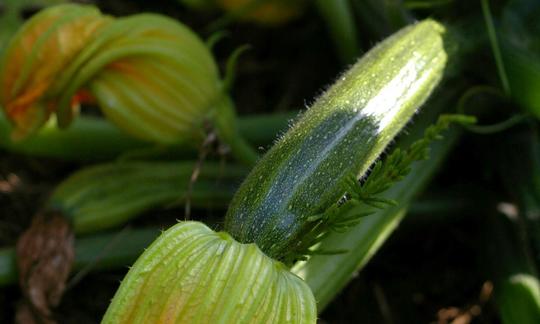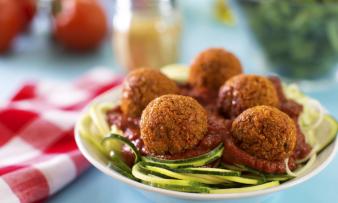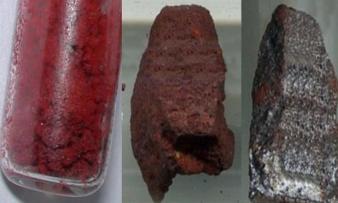Table of contents
Baby zucchini (raw, organic?) ( Cucurbita pepo ssp. pepo ), also known as "mini zucchini", are zucchini that are harvested early. The differences to larger zucchini are the finer taste, more tender flesh and a higher vitamin C content.
Use in the kitchen
The fine texture and delicate taste of baby zucchini is best used in raw food recipes. Cut into thin slices, they taste great in salads. Alternatively, they can be added as a topping at the end of cooked dishes such as pasta sauces, stews or vegetable stir-fries.
The baby zucchini are particularly suitable for pickling in vinegar. Put the small zucchini in a screw-top jar and cover with a mixture of vinegar (e.g. white balsamic vinegar ), water and spices (e.g. garlic , rosemary ,pepper and sea salt ). Then leave the pickled baby zucchini in the fridge for a few days.
When grilling, baby zucchini are an ideal low-calorie alternative to fatty animal products. You coat them with oil and add a little salt. One or two minutes on the grill will give them the delicious grilled aroma, but still retain the fresh taste of the baby zucchini.
In smoothies, zucchini goes well with watermelon ,blueberries or bananas .
Vegan recipe: Zucchini smoothie
Ingredients (for 1 person): 250 ml water, 120 g baby zucchini (organic), 1 banana , 30 g peanut butter, 2 pitted Medjool dates , 30 g young fresh spinach .
Preparation: Wash the vegetables and chop roughly. Place all ingredients in a high-performance blender and puree until a smooth, thick consistency is achieved. Add water as needed.
Vegan recipe for zucchini ricotta lasagne
Ingredients (4 servings): 8 baby zucchini (organic), 100 g fresh spinach , 400 ml tomato sauce, 2 garlic cloves , 1 tbsp tomato paste, 2 tsp yeast flakes , 1 tsp dried oregano , 1⁄2 tsp dried thyme , 1⁄2 tsp dried rosemary , 2 sage leaves, 1 pinch groundblack pepper , 1 tsp curry powder
For the ricotta: 65 g cashews , 1 garlic clove , 60 ml unsweetened soy milk , 7 ml apple cider vinegar , 1 tbsp olive oil , 1⁄2 tsp onion powder , 1 pinch salt , 1 pinch groundblack pepper . Due to the very unfavorable ratio of omega-6 to omega-3 in cashews, macadamia nuts would be much healthier!
To garnish: cherry tomatoes , basil
Soak the cashews in boiling water for 10 minutes. In the meantime, cut the baby zucchini lengthways into leaves using a vegetable peeler or slicer. Cook the spinach in a large pan over medium heat for 1-2 minutes, stirring. As soon as it has wilted, set aside. Drain the soaked cashews and puree with a blender together with the remaining ingredients for the ricotta until smooth.
In a medium saucepan, simmer the tomato sauce, garlic, tomato paste, herbs, curry powder and pepper over medium heat.
Finally, layer the "zucchini leaves", spinach, ricotta and tomato sauce directly on the plate, in portions, like a lasagne. The last layer should be zucchini and ricotta. Garnish with cherry tomatoes and basil leaves.
Vegan recipes with baby zucchini can be found under the note: " Recipes that have the most of this ingredient ".
Purchasing - Storage
Baby zucchini are in season from June to October .
Most major retailers, such as Coop, Migros, Denner, Volg, Spar, Aldi, Lidl, Rewe, Edeka, Hofer, Billa, etc., sell baby zucchini from various countries all year round. If you prefer organic vegetables and don't want to spend a long time looking for them in the shop, we recommend buying them from an organic supermarket (e.g. Denn's Biomarkt or Alnatura). Alternatively, you can buy baby zucchini from regional, seasonal organic boxes.
The availability of baby zucchini varies depending on the size of the store, catchment area, etc. If you are interested, click on our recorded food prices for the DA-CH countries (above under the ingredient image). There you will find current prices from various supermarkets and their price development.
Storage tips
Baby zucchini do not store well. They should be eaten after a week in the fridge at the latest. Always taste a small piece of raw baby zucchini before preparing it. If it tastes bitter, spit it out - it contains the poisonous bitter substance cucurbitacin.
Ingredients - Nutritional values - Calories
The energy content of baby zucchini is 21 kcal/100g. The macronutrients consist of 0.4 g/100g fat, 3.1 g/100g carbohydrates and 2.7 g/100g protein. 1
Baby zucchini contain twice as much vitamin C (34 mg/100g) as the slightly larger "standard zucchini ". Surprisingly, this is as much as is contained in 100 g of grapefruit . Strawberries (59 mg/100g) and blackcurrants (81 mg/100g) have a higher vitamin C content. 1
With 100 g of baby zucchini you can cover 23% of your daily potassium requirement (459 mg/100g). This value is comparable to that of lamb's lettuce (459 mg/100g). Dried herbs contain more potassium; 100 g of dried rosemary contains 955 mg and dried thyme 814 mg. Nuts also contain a lot of potassium (e.g. hazelnuts with 680 mg/100g). 1
Phosphorus is contained at 93 mg/100g. This corresponds to 13.0% of the daily requirement.Pumpkin seeds have a much higher content (1,233 mg/100g). 1 The well-known Styrian pumpkin seeds ( Cucurbita pepo ssp. pepo var. styriaca ) belong to the same species; and even to the same subspecies as zucchini (e.g. Cucubita pepo ssp. pepo var. Black Zucchini). 8
You can find all the ingredients of zucchini, how much it covers your daily needs and comparison values with other ingredients in our nutrient tables below the ingredient image.
Health effects
Important: Zucchini are pumpkins. They are just a special breed. 4 They are classified as summer pumpkins . 5
The word zucchini comes from Italian and means nothing other than small pumpkin. 5 Cucurbita pepo is a very diverse species with countless subspecies. Some of the studies discussed below are about pumpkins ( Cucurbita pepo ). At first glance it seems as if we have suddenly changed the subject. But it is true: due to the large variety of cultivars of Cucurbita pepo , it has not yet been possible to establish a generally valid, nomenclatural, correct classification of cultivar groups for any of these pumpkins. More details can be found in the 'Further information' section. Most studies refer to the species Cucurbita pepo and hardly to specific cultivars or subspecies.
Epidemiological studies show that the risk of developing chronic diseases, including cancer and cardiovascular disease, can potentially be reduced by including sufficient fruit and vegetables in the diet. Phytochemicals are bioactive compounds found in fruit and vegetables that protect cells from damage, i.e. help prevent disease. Zucchini also appears to have these properties. The bio-components contained in zucchini play a positive role in health, as demonstrated by their antioxidant, antimicrobial, anti-inflammatory and antiproliferative activities (inhibiting cell and tissue growth). Antiproliferative effects include, for example, that an extract from yellow zucchini is toxic to human lung cancer cell lines. 9
Researchers investigated the composition and content of bioactive components (polyunsaturated fatty acids, tocopherols and sterols) of the cold-pressed oil from the seeds ( Cucurbita pepo L.) for their wound-healing properties. This study showed in animal experiments the importance of the oil from the seeds ( Cucurbita pepo L.) as a promising agent for wound healing. Pumpkin seed oil is recommended for nutritional and medicinal purposes. 10 Unfortunately, there is no reference to the subspecies in this study.
An additional possible use of Cucurbita pepo is for symptoms of the lower urinary tract associated with benign prostatic hyperplasia (benign enlargement of the prostate that can make urination difficult). One study analyzed the existing literature on the subject. The scientists found 16 studies, ten of which were 'in vitro' and six clinical studies. Anti-inflammatory and anti-androgenic effects as well as a reduction in prostate growth and detrusor activity (detrusor = muscle that surrounds the bladder) can potentially improve the quality of life of affected patients. 11 This study also did not specify which cultivar was used.
The seed extract of Cucurbita pepo in combination with Equisetum arvense (field horsetail) and Linum usitatissimum (common flax) showed in a clinical study that a twelve-week treatment is effective against stress incontinence and the treatment has only minimal side effects. 12
Researchers tested an extract of the seeds of Cucurbita pepo for its effect against nematode infections. Mice infected with Heligmosomoides bakeri The extract was administered - with the result of a significant reduction in parasites. 13
Another study showed promising results regarding the anticarcinogenic potential of zucchini. Zucchini has a direct cytotoxic effect, which is enhanced by its antioxidant properties. The scientists concluded that Cucurbita pepo has the ability to significantly inhibit damage caused by H 2 O 2 and that it has antiproliferative and proapoptotic properties against HL60 tumor cells (a form of leukemia). 14
The mucilage in zucchini has a calming effect on the digestive system. As an easily digestible food, zucchini is recommended for people with digestive problems. 15
To minimize the loss of nutrients, the thermal treatment applied should be different for each food, depending on its nature. In the case of zucchini, freezing and steaming were shown to reduce phenolic compounds and antioxidant activity. 15 Fresh young zucchini taste excellent raw and eating them raw allows you to exploit the full potential of this vegetable.
Dangers - Intolerances - Side effects
Baby zucchini, like all pumpkins, can contain the poison cucurbitacins. The poisonous bitter substances were bred out of the zucchini, but they can always reappear. The poison is heat-stable, and cooking the zucchini offers no protection. 7
The causes of the bitter poison include the zucchini plant's stress reaction to heat and strong temperature fluctuations. A spontaneous back mutation or pollination by bees with ornamental pumpkins can also trigger the release of cucurbitacins. In general, ornamental pumpkins contain high concentrations of cucurbitacins. Even the smallest dose is toxic. 7 Three grams of bitter zucchini can be enough to cause symptoms of poisoning. 16 The symptoms are rapid heartbeat, drop in blood pressure, dizziness, drowsiness, dehydration, nausea, vomiting and gastrointestinal bleeding. 7
Use as a recognized medicinal plant
The following drug monographs classify Cucurbita pepo, more precisely its seeds, Cucurbitae seeds as a recognized medicinal plant: HMPC (2013), ESCOP (2009), Commission E (1991), WHO (Vol. 4). Areas of application are: for nocturnal and involuntary urination, micturition problems (painful urination, frequent bladder emptying), benign prostatic hyperplasia and irritable bladder. 17
Folk medicine - naturopathy
The Herbal Medicinal Products Committee (HMPC) classifies pumpkin seeds as a traditional herbal medicine. Based on many years of experience, pumpkin seeds can be used for urinary tract complaints associated with benign prostatic hyperplasia or an irritable bladder. 17
Due to its antioxidant, anti-cancer, anti-inflammatory, antiviral, antimicrobial and analgesic (pain-relieving) properties, there are numerous folk uses. In traditional folk medicine, zucchini is used to treat colds and relieve pain, 18 or to treat benign prostatic hyperplasia and leprosy. 6
Ecological footprint - animal welfare
The ecological CO 2 footprint of baby zucchinis depends on various factors. For example, the type of cultivation, the country of origin and also the packaging method. Despite extensive research, we were unable to find any precise figures on the ecological CO 2 footprint of baby zucchinis. Compared to zucchinis, however, this could be somewhat higher due to the lower yield per area. This phenomenon can be seen, for example, in cherry tomatoes compared to vine tomatoes. 22
In a 2020 study on the ecological footprints of fruit and vegetables from Germany, a value of 0.2 kg CO 2 eq/kg is given for zucchinis. The production of 1 kg of onions or pumpkins produces similar amounts of emissions. 23 Values from the Netherlands are higher and are around 2.63 kg CO 2 eq/kg. 24 One possible reason for this increased value lies in the cultivation method, as zucchinis are often cultivated in greenhouses here. The amount of water required to produce 1 kg of these Dutch zucchinis is 125 liters. 24 For countries that are already struggling with water shortages due to climatic conditions, efficient water use is particularly important. Research is therefore being carried out into ideal growing conditions for greenhouse zucchini, for example by using mulch or drip irrigation. 25
Conventional agriculture often uses synthetic pesticides and herbicides, which not only have a negative impact on the environment but also pose potential health risks to humans. 26 Some of these pesticides are also found in the final product, as was also found in zucchinis. 27 When shopping, it is ideal to look for organically produced goods, as the use of synthetic fertilizers and pesticides is prohibited.
Worldwide distribution - cultivation
The origin of the zucchini ( Cucurbita pepo ) lies in the Americas. Archaeological finds indicate two independent domestication events: one in Mexico ( C. pepo ssp. pepo ) and the other in the southeastern USA ( C. pepo ssp. ovifera ). The oldest archaeological remains indicate a 10,000-year-old cultural history. 19
During the 16th century, Curcurbita pepo arrived in Europe along with other squash species. The classic oblong squash species, zucchini, a popular variety/subspecies of Curcurbita pepo , originated in Europe and arose as a result of a spontaneous mutation. It is believed that this occurred in Italy in the late 19th century. 21 The term 'zucchini' is the diminutive plural of the Italian word 'zucca' for pumpkin. 3
Today, the undemanding zucchini thrives in many different countries. 2 Its versatility in preparation, mild flavor and nutritional content have made it a staple in many cuisines around the world.
Cultivation - Harvest
Zucchini is a relatively undemanding crop. Heavy soils that tend to become waterlogged and are difficult to warm up are, however, detrimental to good growth. Since zucchini is bisexual, at least two plants should be planted to ensure fertilization and regular fruit set. Direct sowing is only possible from mid-May. 20
In commercial cultivation, it is common to sow up to three times a year at intervals of about 4 weeks. The young plants should not be placed directly next to the older ones in order to prevent the transmission of diseases (mainly powdery mildew). 20
Like all pumpkins, zucchini is sensitive to frost. Zucchini stops growing at temperatures below 10 °C. Temperatures of around 18–24 °C are optimal for a good yield. 20
Zucchini tolerates fresh manure and is grateful for a sufficient supply of garden compost (3-5 kg/m² per plant), as it is a heavy feeder and has a high nutrient requirement. Zucchini has the greatest nutrient requirement during the fruit growth phase. 20
Zucchini require a regular supply of water. Lack of water can stimulate the production of toxic bitter substances and often leads to deformed fruits. A layer of mulch protects the plant from excessive evaporation and suppresses competing weeds. The ideal size for harvesting the fruits is 12-25 cm, but smaller for baby zucchini. Zucchini can ideally be harvested 2-3 times a week, later in the season 1-2 times a week. 20
If you don't have a garden but have a balcony, zucchini can also be grown as a pot plant. 20
In commercial horticulture, great importance is attached to the absence of weeds. In organic farming, this means mechanical or manual control. Mulching film to suppress weeds is also common. This film has the additional advantage that the fruit does not come into contact with the moist soil, thus avoiding pressure marks. Weeds, such as shepherd's purse, and animals such as aphids can be hosts for viruses. 20
Further information
The somewhat confusing botanical classification Cucurbita pepo is due, among other things, to the fact that the term species in biology is defined by the fact that a species can reproduce among itself and produce fertile offspring. The species Curcurbita pepo has a wide variety of forms through breeding, but these can cross-breed with each other.
Zucchini may look different, but it is the same species as the Styrian oil pumpkin. 8
Alternative names
Baby zucchini are also called mini zucchini. In English, the term 'baby/mini zucchini' is also used.









Comments